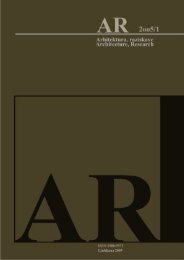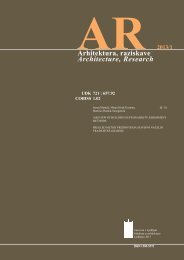AR 2010/1 - Fakulteta za arhitekturo - Univerza v Ljubljani
AR 2010/1 - Fakulteta za arhitekturo - Univerza v Ljubljani
AR 2010/1 - Fakulteta za arhitekturo - Univerza v Ljubljani
Create successful ePaper yourself
Turn your PDF publications into a flip-book with our unique Google optimized e-Paper software.
Kaja Pogačar, Metka Sitar<br />
TIPOLOGIJA ČEZMEJNIH URBANIH OBMOČIJ<br />
Vpogled v tipološke značilnosti<br />
Typology of Cross-border Urban Areas<br />
An insight into typology characteristics<br />
izvleček<br />
Odpiranje notranjih meja med državami članicami Evropske<br />
unije (EU) ni le spodbudilo razvoja različnih družbenoekonomskih<br />
procesov, temveč tudi vzpostavljanje novih<br />
urbanih potencialov v čezmejnih območjih. Kljub opaznim<br />
pri<strong>za</strong>devanjem in interesom <strong>za</strong> oblikovanje čezmejnih regij<br />
in čezmejnih procesov se le-ti odvijajo enostransko predvsem<br />
znotraj specializiranih področij ekonomije, geografije in<br />
družbenih ved. Na splošno vlada manj <strong>za</strong>nimanja <strong>za</strong> raziskave<br />
čezmejnih prostorov z vidika prostorskega in urbanega razvoja<br />
v okviru ozemlja EU.<br />
Članek s predstavitvijo izbranih primerov čezmejnih regij<br />
podaja pregled specifičnih urbanih tvorb in v nadaljevanju skuša<br />
odpreti nekaj novih pogledov v kontekstu slovenskih obmejnih<br />
regij. Na osnovi njihovih morfoloških, ekonomskih in družbenih<br />
značilnosti prepoznava vrste urbanih tipologij, kot so čezmejne<br />
aglomeracije, urbane eksklave, bi-nacionalna obmejna mesta<br />
itd., ki jih analizira iz različnih vidikov prostorskega razvoja.<br />
<strong>2010</strong> / 1 <strong>AR</strong><br />
UDK 711.21 : 341.222<br />
COBISS 1.02<br />
prejeto 28. 2. <strong>2010</strong><br />
abstract<br />
The opening of the internal borders among the member states of the<br />
European Union (EU) has not only caused the development of different<br />
socio-economic processes, but also of new urban potential in the areas<br />
lying across the national borders. Although there has recently been a<br />
remarkable upsurge of activities and interests in the regions and areas<br />
along the borders regarding the formation of border regions and crossborder<br />
processes, they mostly remain quite rigidly within specialised<br />
disciplinary fields, i.e. economy, geography, and sociology. There is,<br />
however, much less interest in cross-border areas seen in the light of<br />
spatial and urban development processes within EU integration.<br />
The article provides an overview of specific urban formations through<br />
the presentation of selected cases of cross-border regions and, in<br />
addition, aims to open some new issues with regard to the context<br />
of Slovenian border regions. On the basis of their morphological,<br />
economic, and social characteristics, a range of urban typologies,<br />
such as cross-border agglomerations, urban exclaves, bi-national<br />
border cities etc. will be identified and analysed from different aspects<br />
of spatial development.<br />
ključne besede<br />
obmejne regije, mejni prehodi, dvo-nacionalna obmejna mesta,<br />
čezmejne aglomeracije, linearni urbani predeli, urbane eksklave<br />
key words<br />
border regions, border-crossings, bi-national border cities, crossborder<br />
agglomerations, linear urban sites, urban exclaves.<br />
The linking of individual states within the European Union (EU) has<br />
set in motion numerous changes in the operation and organisation of<br />
space. This article focuses on cross-border areas in which, as a result<br />
of the removal of borders, concerning the reorganisation of living<br />
conditions, great changes are taking place in many domains, and<br />
at the same time, new challenges are arising. In addition, it should<br />
be stressed in particular that, before incorporation into the EU, the<br />
cross-border areas had been relegated to the periphery. They were<br />
culturally undefined, marginalised and generally less developed. This<br />
phenomenon can be attributed, among other factors, to the specific<br />
organisation of EU territory, which throughout history had been<br />
characterised by its subdivision into numerous relatively small states,<br />
and, furthermore, by frequently changing national borders. Thus,<br />
within this system, which conceived of national states as closed, selfsufficient<br />
units, a functional duality of space was created. It found<br />
expression in the division into a central sphere and a periphery on state<br />
borders. These cross-border areas have seen many spatially extremely<br />
negative, even tragic stories. Stories of the consequently repressive<br />
measures happened because of the newly established borders, and<br />
the ensuing interlinked consequences, such as declining populations,<br />
restricted freedom of movement, etc. They were reflected in the<br />
urbanisation of space, which gradually became subjected or adjusted<br />
to these transformations.<br />
The EU framework has established new starting points for the<br />
development of cross-border areas, as they have been becoming key<br />
elements in the process of integration, economic, and social cohesion<br />
[EC-European Commission, 2002a]. New theoretical understandings<br />
are taking shape, which are the result of studying the phenomenon<br />
of creating border- and cross-border-regions as integral functional<br />
regions. Different approaches and definitions have been invented,<br />
and questions raised with regard to the potential of these new urban<br />
structures, which are appearing within the territories of different<br />
formations at national, provincial, regional, and local levels.<br />
As a starting point, the article represents an insight into the general<br />
and spatial characteristics of border areas. A selection of specific<br />
cases of urban typologies occurring in cross-border areas is then<br />
presented in detail. The methodology of seeking and defining crossborder<br />
typologies is, however, not only limited to summarising data<br />
from different sources. The aim of the analyses is also to provide an<br />
overview of special structures of urban development in cross-border<br />
areas in order to throw light upon new issues concerning the state of<br />
the art in the urban and regional context. Additionally, the analyses<br />
will result in raising new questions, which are interesting in the<br />
Slovenian context and require more detailed research.<br />
National border and cross-border regions in the framework<br />
of the EU<br />
National borders and cross-border regions have quite a special<br />
role within European territory, since its spatial-political geography<br />
is different from those of the other continents. The specific geopolitical<br />
structure has resulted from historical changes to borders that<br />
transformed the region from formerly vast imperial areas into many<br />
comparatively small nation-states. Such structuring has been<br />
10

















